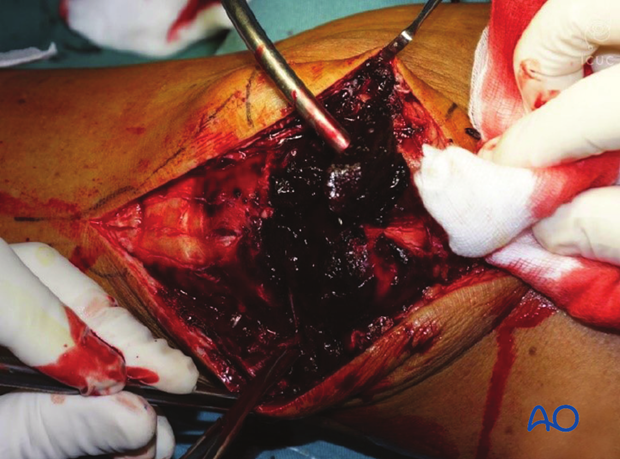Cerclage wire
1. Principles
Treatment goal
The patello-femoral joint is biomechanically very stressed when the knee is loaded. Any compromise of the joint surface is likely to lead to degenerative joint disease. It is, therefore, highly desirable, in patellar fractures to strive for anatomical reduction of the joint surface and stable fixation.
In wedge or multifragmentary complete articular fractures, anatomical reduction of the joint surface in relation to all the fragments, combined with durable restoration of the integrity of the extensor mechanism is not commonly achievable.
Cerclage wiring draws the fragments together as anatomically as possible and permits controlled quadriceps rehabilitation in the medium to late healing phases. The joint surface commonly heals with some irregularity, predisposing to secondary degenerative joint disease.
An additional treatment goal is restoration of function of the knee extensor mechanism and allow early range of motion of the knee.

Combination of techniques
In fractures with several large fragments and disruption of the extensor mechanism, cerclage wiring may be used alone, or in combination with lag screw fixation or plating.
If cerclage wiring is used alone, it must be supplemented with a period of splintage or hinged knee bracing.

Verification of reduction
Anatomical reduction of the articular surface is monitored by palpating the joint from inside, as neither inspection nor the x-ray will reveal a minor step off. This will require creation of a small arthrotomy.
Nevertheless, an image intensifier or X-ray should always be available, so that the reduction can be checked in the AP and lateral planes if needed.

2. Patient preparation and approach
Patient preparation
This procedure is normally performed with the patient in a supine position with the knee flexed 30°.

Approach
For this procedure a mid-axial longitudinal approach is used.

3. Reduction and fixation
Fracture debridement
The knee joint and fracture lines must be irrigated and cleared of blood clot and small debris to allow exact reconstruction.

Reduction
Reduce the major fracture fragments using a pointed bone reduction forceps or tenaculum. Transverse fractures are more easily reduced with the leg in extension and sagittal fractures are more easily reduced with the leg in extension.
Verify the reduction by palpation of the retropatellar surface if possible.

Inserting the cerclage wire
Choose a wire of enough strength to withstand the tensile forces generated in the cerclage (1.0 – 1.25 mm diameter).
The wire should be as close as possible to the bone throughout its whole course both superiorly and inferiorly. The use of a curved large bore injection needle may be helpful.

The wire is then similarly threaded around the circumference of the body of the patella and its lower pole, as illustrated.

Wire tightening
Loosely prepare the wire twist ensuring that each end of the wire spirals equally - the twist should not comprise one spiral around a straight wire.

Carefully tighten the wire while pulling away from the patella as the wires are twisted. Avoid over-tightening as this may distort the overall shape of the patella.
The wires should be twisted at least 5 times to prevent fixation failure. When stainless steel wires tighten they will lose the surface sheen and if tightened further the wire may break.
When the correct tension is achieved, twist and trim the wire ends.
Care should be taken finally to position the twisted wire into deeper soft-tissue muscle layers, if possible.
Verify the reduction by palpation of the retro patellar surface if possible.

Additional stabilization
The major fragment may additionally be fixed using a lag screw.

4. Aftercare following cerclage wiring of patellar fractures
Introduction
Active knee function requires an intact knee extensor mechanism, a mobile patella, a well-preserved patello-femoral joint and muscle strength.
Knee stiffness and muscle weakness can become a problem after the necessary period of splinting. Once deemed to be healed, a regimen of progressive knee mobilization and muscle strengthening must be supervised closely by the rehabilitation team.
Functional treatment
Cerclage wire fixation alone may not be completely stable. A period of splinting with the knee in extension, may be required. Early active knee flexion and mobilization of the patient may be started with caution immediately after surgery. Static isometric quadriceps exercises should be started on postoperative day 1 with the knee extension splint in place. At a later stage (3 to 6 weeks), special emphasis should be given to active knee and hip movement.
Weight bearing
A removable knee splint is applied postoperatively and worn until full quadriceps control is regained. Full weight bearing may be performed using crutches, or a walker, from postoperative day 1. A brace is usually used until 3 weeks after surgery.
Follow-up
Wound healing should be assessed regularly within the first two weeks. X-rays should be taken at 2, 6 and 12 weeks. A longer period may be required if fracture healing is delayed.
Implant removal
Implant removal may be required, as the wires may be prominent under the skin. Implant removal should not be undertaken until a minimum of 1 year postoperatively. Patients should be warned that cerclage wires may break during the healing process and may need to be removed somewhat earlier.
Thrombo-embolic prophylaxis
Consideration should be given to thrombo-embolic prophylaxis, according to local treatment guidelines.













